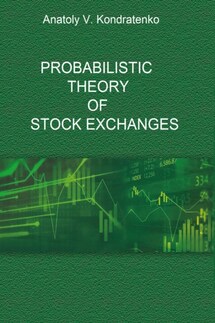Probabilistic Theory of Stock Exchanges - страница 11
We emphasize that in these principles, if we consider them one by one, we can almost always find their «roots» in separate works of the previously cited authors of classical economic theory: Adam Smith (theory of commodity exchange, etc.), Carl Menger (theory of subjective value, etc.) and Ludwig von Mises (principle of methodological individualism, concept of market process, dynamic interpretation of S&D law, etc.). Here they are brought together, formulated quite clearly and it is emphasized that they should be taken into account simultaneously in the development of any economic theory, claiming for an adequate description of the real economic world, in which living people, rather than fictional characters like homo economicus in imaginary markets with perfect competition and with a supposedly all-powerful market hand, formed only by agents representing people and business without regard to the role of the state. What is brand new here, are the dynamic and evolutionary principle with the idea of finding equations of motion for market agents, the trade volume maximization principle to establish trends in the movement of market prices and the uncertainty and probability principle with the idea of using probabilistic strategies that the agents use to put their quotations and, most importantly, the elaborated mathematical apparatus, which allows for extensive quantitative research of real economic systems, including organized markets.
To develop a probabilistic theory of the exchange, a physical method of economic research was used, the essence of which consists in using standard theoretical approaches of physics for modeling and calculating economic systems, with subsequent constant comparison of calculation results with experimental data to verify the used approaches, models and theory as a whole and for the purpose of establishing thereby the applicability limits of models and theory as a whole in those cases where their improvement and development is feasible. If the results of calculations contradict the experiment to a sufficient degree, the theory should be rejected without hesitation, and the process of theory creation should be started anew. For the sake of certainty and clarification of the theoretical problems studied in this book, we further call this option of the physical method application “a solution of the direct problem of the economic theory”, in which the results of economic activity (in this book, stock trading) are calculated based on some initial principles (ab initio principales), which are then compared with the corresponding experimental data (in our case – with the results of stock trading). We oppose this approach to solving, shall we say, the inverse problem of economic theory, in which by mathematical processing of experimental data one seeks to obtain information about the studied economic system. It should be said that we borrowed the terms "direct and inverse problem" from the theory of elementary particles scattering, which solves formally similar problems. It is known that solving the inverse problem in physics is very difficult and there is no reason to think that solving the inverse problem in economics will be easier. Here we reserve to developing the methods for solving the direct problem of economics as applied to stock exchanges, so all conclusions and discussions in this book refer only to the direct problem of economic theory, unless specifically stated. In order to avoid misunderstandings, we will repeatedly emphasize this aspect of this study.







